We have moved our composter and we have placed it under the lemon tree, there the sun does not hit it directly and it is not in the way as in the place where it was, and as it was to imagine when moving what it contains, we have begun to see again some soldier flies, but these that I managed to see and photograph today I had not observed them previously, this species is less robust than the black soldier flies, these are of the species Sargus fasciatus that are also called soldier flies of the centurion.
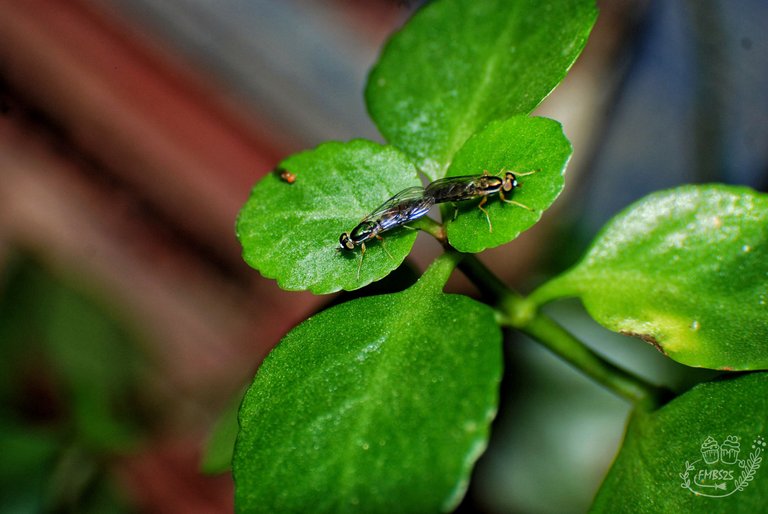
When we see them in flight they are more similar to a wasp by the thinness of its abdomen, its large eyes, short antennae and that color are certainly typical of a fly, these are lovers of decaying leaves and fruits and are commonly found in the compost, which is where they love to deposit their eggs and as you can see in the pictures soon there will be many of these in my garden.
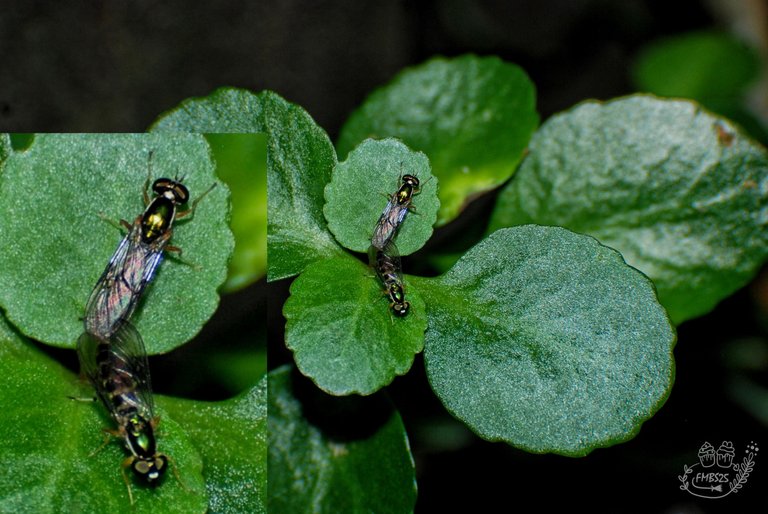
I couldn't tell if like the black soldier fly - Hermetia illucens, sargus pupae are also edible, although it's certainly something I don't intend to include in my diet, it's quite interesting information.
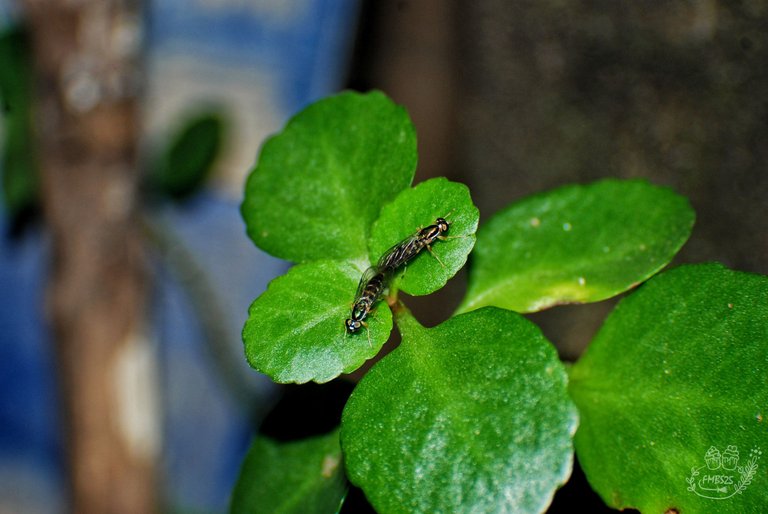
There is little information regarding this species punctually found on the internet, however, based on the characteristics of the genus itself, and assuming that they have a similar behavior to other soldier flies, it can be said that they feed on flower nectar and some only devote their adult period to reproduction, which in addition to grow and reproduce in compost bins, we can find them in remains of dead animals, decaying leaves and trees and even in animal droppings, so I do not see anything nice that they say that you can consume their pupae.
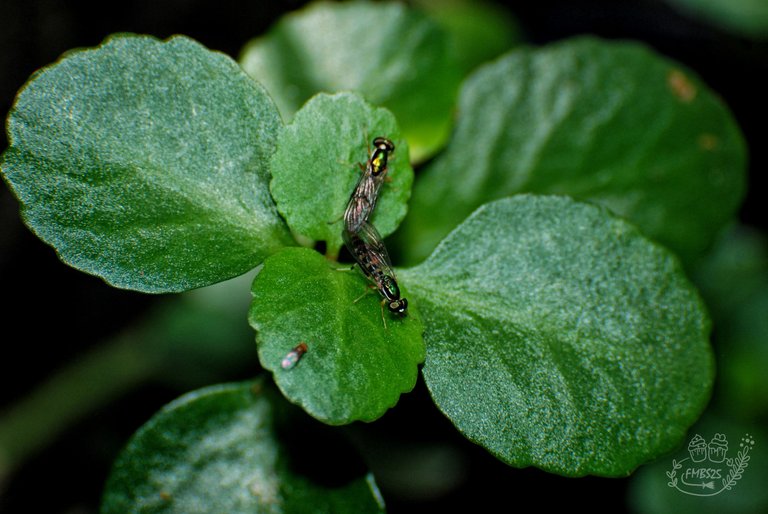
I also found on the same love plant (hahaha) this small fly Neogriphoneura sordida, these also live on dry and decaying leaves and these days of rain have caused some rotten leaves that perhaps have caused the arrival of these small ones that are not so good for some plants, especially those with delicate flowers as they tend to damage the small flowers.
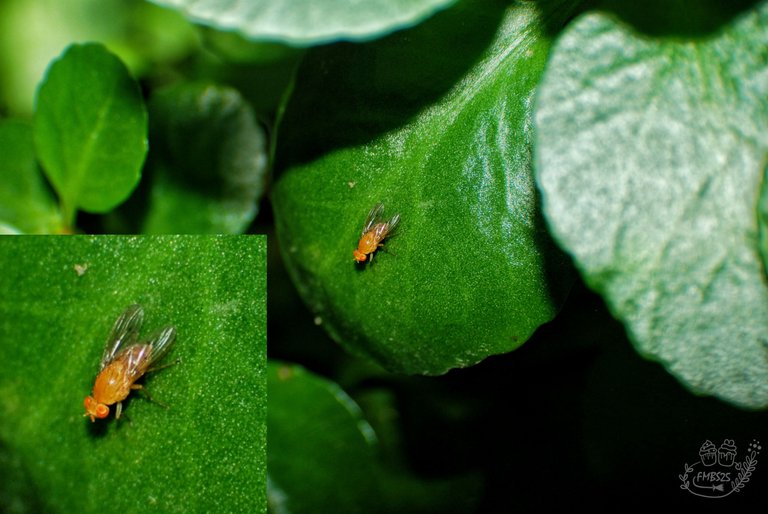
Images of my own, taken with my Nikon D80 Camera, Edited with Snapseed.
Thank you for taking the time to read this post, if you have any questions, criticisms or suggestions, I would appreciate it if you would put them in the comment box, and remember, You too can make magic in the kitchen and wherever you go!



Created by @derangedvisions


When we see them in flight they are more similar to a wasp by the thinness of its abdomen, its large eyes, short antennae and that color are certainly typical of a fly, these are lovers of decaying leaves and fruits and are commonly found in the compost, which is where they love to deposit their eggs and as you can see in the pictures soon there will be many of these in my garden.

I couldn't tell if like the black soldier fly - Hermetia illucens, sargus pupae are also edible, although it's certainly something I don't intend to include in my diet, it's quite interesting information.

There is little information regarding this species punctually found on the internet, however, based on the characteristics of the genus itself, and assuming that they have a similar behavior to other soldier flies, it can be said that they feed on flower nectar and some only devote their adult period to reproduction, which in addition to grow and reproduce in compost bins, we can find them in remains of dead animals, decaying leaves and trees and even in animal droppings, so I do not see anything nice that they say that you can consume their pupae.

I also found on the same love plant (hahaha) this small fly Neogriphoneura sordida, these also live on dry and decaying leaves and these days of rain have caused some rotten leaves that perhaps have caused the arrival of these small ones that are not so good for some plants, especially those with delicate flowers as they tend to damage the small flowers.

Thank you for taking the time to read this post, if you have any questions, criticisms or suggestions, I would appreciate it if you would put them in the comment box, and remember, You too can make magic in the kitchen and wherever you go!
[ES]


Hemos movido de lugar nuestro compostero y lo hemos colocado bajo el limonero, allí el sol no le da de manera directa y no estorba como en el sitio donde estaba, y como era de imaginar al mover lo que contiene, se han empezado a ver nuevamente algunas moscas soldados, pero estas que logre ver y fotografiar hoy no las había observado anteriormente, esta especie es menos robusta que la moscas soldado negro, estas son de la especie Sargus fasciatus que también son llamadas moscas del soldado del centurión.

Cuando las vemos en vuelo son mas similares a una avispa por lo delgado de su abdomen, sus grandes ojos, antenas cortas y ese color son sin duda típicos de una mosca, estas son amantes de las hojas y frutas en descomposición y comúnmente son encontradas en la composta, que es donde aman depositar sus huevecillos y que como podrán observar en las fotografías próximamente habrá muchos de estos en mi jardín.

No podría decir si al igual que la mosca soldado negra - Hermetia illucens, las pupas de las sargus también son comestibles, aunque sin duda es algo que no pretendo incluir en mi dieta, es una información bastante interesante.

Es poca la información referente a esta especie puntualmente que se encuentra en la internet, sin embargo, basándose en las características del género en sí, y asumiendo que tienen un comportamiento similar a otras moscas soldados, se puede decir que se alimentan de néctar de las flores y algunos solo dedican su periodo de adultez a la reproducción, que además de crecer y reproducirse en los composteros, podemos encontrarlos en restos de animales muertos, hojas y árboles en descomposición e incluso en excremento de animales, por lo que no veo nada agradable eso que dicen de que se pueden consumir sus pupas.

También me encontré en la misma planta del amor (jajaja) esta pequeña mosca Neogriphoneura sórdida, estas también viven en las hojas secas y en descomposición y estos días de lluvia han provocado algunas hojas podridas que quizás hayan provocado la llegada de estas pequeñas que no son tan buenas para algunas plantas, en especial las que tienen flores delicadas ya que tienden a dañar las pequeñas flores.

Imágenes de mi propiedad, tomadas con mi Camara Nikon D80, Editadas con Snapseed .
Gracias por tomarse el tiempo de leer esta publicación, si tiene alguna pregunta, crítica o sugerencia, la agradecería que la pusiera en la caja de comentarios, y recuerda, ¡Tú también puedes hacer magia en la cocina ya dondequiera que vayas!

Created by @robinsonlgil





Come and support @Cervantes as Witness in https://peakd.com/me/witnesses




Cuando las vemos en vuelo son mas similares a una avispa por lo delgado de su abdomen, sus grandes ojos, antenas cortas y ese color son sin duda típicos de una mosca, estas son amantes de las hojas y frutas en descomposición y comúnmente son encontradas en la composta, que es donde aman depositar sus huevecillos y que como podrán observar en las fotografías próximamente habrá muchos de estos en mi jardín.

No podría decir si al igual que la mosca soldado negra - Hermetia illucens, las pupas de las sargus también son comestibles, aunque sin duda es algo que no pretendo incluir en mi dieta, es una información bastante interesante.

Es poca la información referente a esta especie puntualmente que se encuentra en la internet, sin embargo, basándose en las características del género en sí, y asumiendo que tienen un comportamiento similar a otras moscas soldados, se puede decir que se alimentan de néctar de las flores y algunos solo dedican su periodo de adultez a la reproducción, que además de crecer y reproducirse en los composteros, podemos encontrarlos en restos de animales muertos, hojas y árboles en descomposición e incluso en excremento de animales, por lo que no veo nada agradable eso que dicen de que se pueden consumir sus pupas.

También me encontré en la misma planta del amor (jajaja) esta pequeña mosca Neogriphoneura sórdida, estas también viven en las hojas secas y en descomposición y estos días de lluvia han provocado algunas hojas podridas que quizás hayan provocado la llegada de estas pequeñas que no son tan buenas para algunas plantas, en especial las que tienen flores delicadas ya que tienden a dañar las pequeñas flores.

Gracias por tomarse el tiempo de leer esta publicación, si tiene alguna pregunta, crítica o sugerencia, la agradecería que la pusiera en la caja de comentarios, y recuerda, ¡Tú también puedes hacer magia en la cocina ya dondequiera que vayas!






 Discord@Ecotrain Discord@Ecotrain |  |
|---|---|
| Discordhttps://steemitimages.com/640x0/https://ipfs.busy.org/ipfs/QmNmqVvqjT9vUukyqi1PWVvceFNA32BUqpMj1kME7PdSib @upmewhale |  |






The rewards earned on this comment will go directly to the person sharing the post on Twitter as long as they are registered with @poshtoken. Sign up at https://hiveposh.com.
Your content has been voted as a part of Encouragement program. Keep up the good work!
Use Ecency daily to boost your growth on platform!
Support Ecency
Vote for Proposal
Delegate HP and earn more
The photographs of insects in the process of mating is something that really fascinates me, because in some cases it is something striking and beautiful since it is nature in action.:)
Aside from being nature in action, it is something that is rare to find, which makes it a wonderful thing to be able to capture these moments.